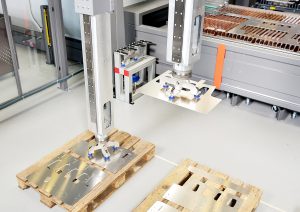 Today’s Fiber laser cutting machines process three to four times more volume of material per unit of time than legacy CO2 laser cutting machines. To maintain this consistent pace of production, it is critical to have some form of material handling automation.
Today’s Fiber laser cutting machines process three to four times more volume of material per unit of time than legacy CO2 laser cutting machines. To maintain this consistent pace of production, it is critical to have some form of material handling automation.
Consistency of the laser cutting system, including material handling, cutting, sorting and disposal of the cut sheets, is the key to maintaining efficiency and throughput. Automation provides that consistency.
Operating a Fiber Laser
If you were to ask the operator of a Fiber laser cutting machine, who also previously operated a CO2 laser cutter, how different operating one is from the other, one answer will likely center around the considerably faster throughput of the Fiber laser. In the past, CO2 laser operators had time to perform multiple tasks between cycles. They would unload the cut parts, dispose of the material skeleton, retrieve and load new materials and enter production data into the job tracking system, all in the time between cycles. That is no longer possible in most cases with Fiber laser cutting equipment, and it is with this faster pace of loading and unloading that inefficiencies will magnify and physical fatigue will set in. While operators can be very efficient at the loading and unloading process, eventually there will be situations where the machine will not have the required raw material available. This may be due to a variety of factors such as lack of available time, breaks, mealtime, shift changes, and meetings.
Measuring for Efficiency
If you purchased a Fiber laser, you did so with the realization that you would gain additional throughput and create higher margins and revenue. Any non-productive waiting time will erode these gains. With today’s machines and software, you can measure the entire process from start to finish and gather performance statistical data. If you are not currently operating with laser automation, measure the process and look to see where there are non-productive waiting times. Is your machine waiting for programs, raw materials, unloading of cut parts, unknown operator machine stops? Measuring these times will surely provide insight into your current level of efficiency or inefficiency and enable you to make the proper adjustments. After all the procedural corrections have been made, automating the process will still provide the greatest level of throughput and efficiency. Measuring and accounting for lost productivity and lost revenue is the best way to justify adding automation. Another important consideration in choosing the correct automation system is the load/unload cycle time. With today’s high-speed laser cutting technology, the automation cycle time is critical to ensure that the material handling system will not begin to pace the laser.
Automating for Efficiency
Each component of automation introduced into the laser cutting process will increase the efficiency of cutting operations. Automated load/unload systems can automatically load materials from a raw material stack, remove the finished parts, sort them onto pallets and remove the material skeleton to an unload location. This type of system provides the consistency that is required of today’s highly productive Fiber laser cutting systems. Utilizing a material storage tower in conjunction with an automated material load/unload unit also greatly increases efficiency when changing materials.
Advancements in Automation
Many advancements in automation technologies have occurred since the introduction of Fiber lasers ten years ago. Automation technologies have grown out of the necessity of maintaining the pace with ever-evolving Fiber laser cutting systems. Automation at the front-end of the process has enabled programs to be produced faster. Automated material storage, and load and unload systems have increased efficiencies related to material handling. Automated sorting systems have eliminated the manual sorting of parts so that the operations that follow can be fulfilled just as quickly as parts are produced on the laser. All of these automated technologies enable fabricators to maintain the pace with highly productive Fiber laser cutting systems and reap the maximum benefits from their investments.
By Frank Arteaga, Head of Product Marketing, NAFTA Region Bystronic Inc., Elgin, IL – Voice.bystronic@bystronic.com
